The manufacturing industry has a long tradition of machine shop employees wanting to be their own boss and starting their own shops. Gary Lee took a similar path but with a twist.
At the age of 20, after having worked at a foundry, he became the 12th employee at an Illinois machine shop and, over the next 15 years, ran the purchasing department, helping the shop grow into a $30 million company with more 100 employees.
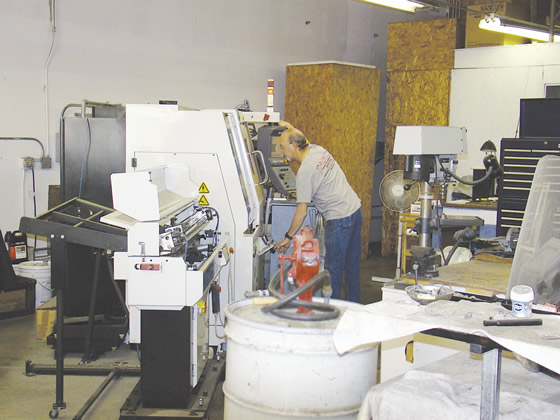
In addition to waterjet machines, JDA operates CNC milling and turning machines, such as this Hurco lathe operated by Karl Gruszkowski.
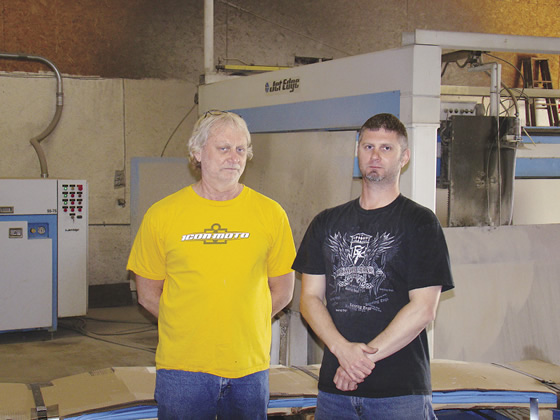
Gary Lee (left), president of JDA Aqua Cutting and JDA Custom, says his son Joshua, vice president, has played an instrumental role since the shops’ beginning.
However, by then, Lee said he was “bored to death” and wanted to take his enthusiasm for manufacturing and make money on his own. “By the time I was 35, there was nowhere for me to go there because it was a family-run business and their kids were coming in.”
But rather than establishing a shop to machine jobs similar to those tackled by his previous employer, Lee launched JDA Aqua Cutting Inc. in 1995 in New Lenox, Ill., becoming one of the early adopters of waterjet cutting in the Chicago area. He started with a high-rail gantry waterjet machine from Chukar WaterJet and a 55,000-psi, 50-hp intensifier pump from St. Michael, Minn.-based Jet Edge Inc., which acquired Chukar in 1998. Lee added that the tools he needed for general operations came from his garage.
Those tools have been replaced, but that waterjet machine—as well as a second Jet Edge high-rail gantry waterjet with a 75-hp intensifier pump the shop purchased about 4 years later—haven’t. “We’ve had pretty good luck with them,” Lee said, adding that JDA Aqua Cutting performs all machine maintenance and repair in-house, with Jet Edge providing consultation.
Although business was modest at first, word began to spread about the company’s capabilities to accurately, productively and intricately waterjet-cut virtually any material, with or without the use of abrasive garnet. “Within 2 years, our business started going nuts,” Lee said.
Family Roots
The letters JDA in the company’s name represent the initials of Gary and LaSondra Lee’s three sons: Joshua, Daniel and Andrew. The Lees also have a daughter, Rachel, the youngest, but felt the three-letter acronym looked and sounded better than one with four.
Lee instructs his children to “do what you want in this world,” and, for the majority, that doesn’t include machining. The exception is Joshua, who started working at the shop while still a freshman at Illinois Institute of Technology, where he received a baseball scholarship and earned engineering degrees. “He was coming in nearly 40 hours a week and helping me,” Lee said, adding that Joshua now basically runs the 13,000-sq.-ft. shop.
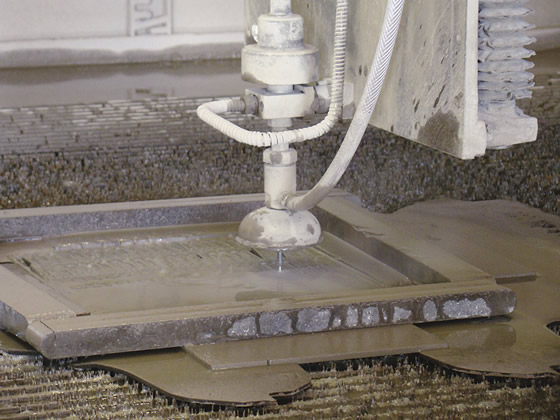
JDA Aqua Cutting operates its Jet Edge waterjet machines up to 15 hours a day, 6 days a week.
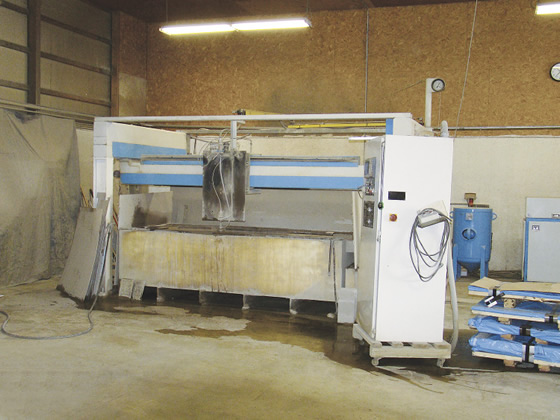
JDA Aqua Cutting still runs the first waterjet machine it purchased in 1995.
To help smooth the cyclic nature of the job shop business, especially after the slowdown caused by the 9/11 terrorist attacks, the shop sought to develop its own product line. Lee noted JDA produced radius walkways components and other parts for the destroyed World Trade Center. What the nature of that line should be was elusive until Joshua made a chain guard for his motorcycle and a friend requested one for his bike as well. As a result, the Lees decided to produce custom parts for sport motorcycles and started JDA Custom. “We have about 3,800 part numbers and ship parts all over the world,” Gary Lee said about the JDA Custom line.
The bike parts are typically machined from bar stock and the company purchased a Hurco CNC lathe to complement its existing Hurco CNC mills and enable machining of all the required bike part features and enhance its job shop capabilities, Lee noted. He added that about 65 percent of the business is job shop work, with the remainder being for JDA Custom, which slows a bit during winter.
The two sides of JDA share the machine tools, with the waterjet machines often roughing parts for finishing on the milling machines. In addition to machining, including sawing, JDA performs forming/bending, welding, vibratory deburring and other finishing processes, and provides design and engineering services. According to Lee, the only outsourced work is plating and heat treating—even part and motorcycle photography is done in-house.
Style and Performance
The company’s motorcycle photography came about when they began building their own motorcycles. JDA Custom performs three to four high-end builds each year. “We’re really tight with Yamaha and Suzuki,” Lee said, noting the bikes are sold as JDA Custom creations.
Kawasaki is another cycle manufacturer JDA Custom has an association with. One project was a custom built 2012 Kawasaki ZX14R for a Nigerian customer. As reported in the cover story from the September 2013 issue of Thunder Roads Wisconsin/Northern Illinois magazine, alterations include an intense yellow-body-with-fine-black-flames paint job by JP Customs, a Roaring Toyz single-sided swingarm, a massive donut-style rear tire, upgraded brakes, Performance Machine rims, gleaming chrome accessories from JDA Custom and a Short Allen Head 2, full system exhaust from Brocks.
In addition, JDA distributes an array of riding gear and accessories, including boots and shoes, clothing, exhaust systems, swingarms, sprockets and chains, fat-tire kits and wheels.
After JDA established its product line, the company’s reputation for high-quality machining services began to grow and JDA experienced 25 to 30 percent annual growth in the combined businesses, according to Lee. Along with that came an expanding range of projects and materials that required waterjetting. The shop has experience waterjet cutting paper, rubber, glass, rosewood for guitar fretboards, shim stock as thin as 0.001 " (0.025mm), 316 stainless steel forgings up to 8 " (203.2mm) thick, steel hardened to 60 HRC and exotic metals. One exotic job was a 3½ "-thick × 48 "-wide × 102 "-long (88.9mm × 1,219.2mm × 2,590.8mm) piece of Inconel for a nuclear power application that weighed 4,400 lbs. (1,996 kg) and was valued at $132,000.
“Basically any kind of material that’s out there, we’ve had pretty good luck with,” he said. However, waterjetting laminated parts is a challenge because the process tends to delaminate them.
Lee noted some of the jobs for more well-known customers include displays for high-end retailers, ashtrays with baseball team logos for a former major leaguer, inlay flooring for the skyboxes at U.S. Cellular Field in Chicago, ceiling panels with the Green Bay Packers’ logo for Lambeau Field, tumbling practice mats for the Chicago Bulls Luvabulls cheerleaders, panels for a globe at Chicago’s Adler Planetarium and brass TV frames with the Playboy Bunnies design for the Playboy casino in Las Vegas. Another high-visibility project involved cutting circles out of encyclopedias for the Art Institute of Chicago to create an exhibit where the circles were extracted and suspended from the suspended encyclopedias. “It was like looking into a book and pulling out knowledge,” Lee said.
No Need for New
Similar to numerous other part manufacturers, JDA saw business drop 52 percent in 2009 as a result of the Great Recession, as well as work being outsourced to low-labor-cost countries, Lee said. The company went from employing 16 workers on two shifts to six workers on one shift to a shift and a half. While business returned to a growth mode last year, it’s far from prerecession levels. “Before the recession, we were probably shipping 150 boxes of bike parts a day and now it’s probably 40,” he said, adding that a majority of its smaller bike-part competitors are no longer in business. “You don’t go to school to learn how to live through a recession that lasts 5 years.”
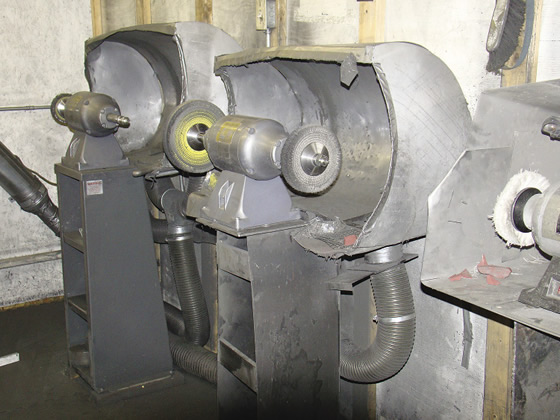
Ducting helps control the air quality in the shop’s part finishing area.
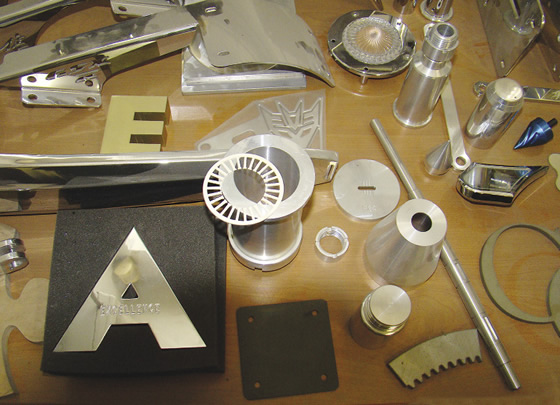
JDA Aqua Cutting and JDA Custom produce an array of parts.
With regular maintenance, such as replacing seals and nozzles, Lee said he is able to keep his 15- and 19-year-old waterjet machines up and running while achieving close tolerances and keeping taper to a minimum—as low as 0.005 " (0.127mm) per side when cutting 6½ "-thick (165.1mm) forgings for the oil rig industry. He added that taper compensation isn’t required because he has a thorough knowledge of his waterjet machines and effectively and productively uses a “bare-bones” CAD/CAM package from Jet Edge.
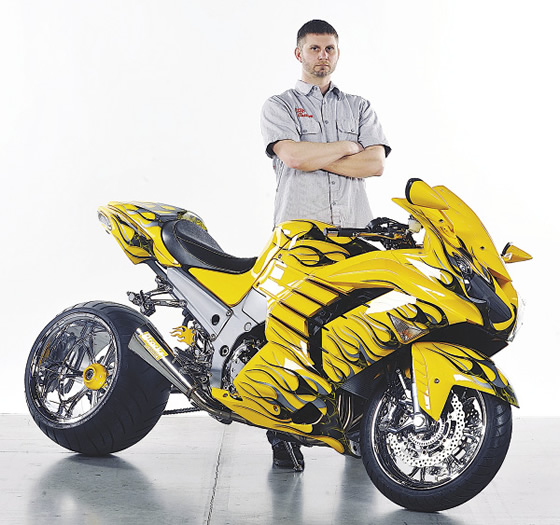
Joshua Lee and the 2012 Kawasaki ZX14R JDA Custom built for a Nigerian customer.
“I don’t trust auto nesting,” Lee said. “We have used nesting/CAM programs that cost thousands of dollars and sent them back a month later. The programs were faulty and not a reliable source for nesting and productivity. It may be considered ‘old school,’ but I rely on my experience from 19 years of programming and being able to read G code to provide the most reliable programs.”
Although Lee might attend the International Manufacturing Technology Show in Chicago this year to experience what the event has to offer, he won’t be taking a shopping list along and isn’t interested in acquiring equipment until he has a better idea about where the economy is heading. “I can run three shifts before I have to buy anything,” he said. CTE
For more information about JDA Aqua Cutting Inc. and JDA Custom, call (815) 485-8028 or visit www.jdaaqua.com and www.jdacustom.com.
About the Author: Alan Richter is editor of CTE. Contact him at (847) 714-0175 or [email protected].
Related Glossary Terms
- abrasive
abrasive
Substance used for grinding, honing, lapping, superfinishing and polishing. Examples include garnet, emery, corundum, silicon carbide, cubic boron nitride and diamond in various grit sizes.
- computer numerical control ( CNC)
computer numerical control ( CNC)
Microprocessor-based controller dedicated to a machine tool that permits the creation or modification of parts. Programmed numerical control activates the machine’s servos and spindle drives and controls the various machining operations. See DNC, direct numerical control; NC, numerical control.
- gang cutting ( milling)
gang cutting ( milling)
Machining with several cutters mounted on a single arbor, generally for simultaneous cutting.
- lathe
lathe
Turning machine capable of sawing, milling, grinding, gear-cutting, drilling, reaming, boring, threading, facing, chamfering, grooving, knurling, spinning, parting, necking, taper-cutting, and cam- and eccentric-cutting, as well as step- and straight-turning. Comes in a variety of forms, ranging from manual to semiautomatic to fully automatic, with major types being engine lathes, turning and contouring lathes, turret lathes and numerical-control lathes. The engine lathe consists of a headstock and spindle, tailstock, bed, carriage (complete with apron) and cross slides. Features include gear- (speed) and feed-selector levers, toolpost, compound rest, lead screw and reversing lead screw, threading dial and rapid-traverse lever. Special lathe types include through-the-spindle, camshaft and crankshaft, brake drum and rotor, spinning and gun-barrel machines. Toolroom and bench lathes are used for precision work; the former for tool-and-die work and similar tasks, the latter for small workpieces (instruments, watches), normally without a power feed. Models are typically designated according to their “swing,” or the largest-diameter workpiece that can be rotated; bed length, or the distance between centers; and horsepower generated. See turning machine.
- milling
milling
Machining operation in which metal or other material is removed by applying power to a rotating cutter. In vertical milling, the cutting tool is mounted vertically on the spindle. In horizontal milling, the cutting tool is mounted horizontally, either directly on the spindle or on an arbor. Horizontal milling is further broken down into conventional milling, where the cutter rotates opposite the direction of feed, or “up” into the workpiece; and climb milling, where the cutter rotates in the direction of feed, or “down” into the workpiece. Milling operations include plane or surface milling, endmilling, facemilling, angle milling, form milling and profiling.
- sawing
sawing
Machining operation in which a powered machine, usually equipped with a blade having milled or ground teeth, is used to part material (cutoff) or give it a new shape (contour bandsawing, band machining). Four basic types of sawing operations are: hacksawing (power or manual operation in which the blade moves back and forth through the work, cutting on one of the strokes); cold or circular sawing (a rotating, circular, toothed blade parts the material much as a workshop table saw or radial-arm saw cuts wood); bandsawing (a flexible, toothed blade rides on wheels under tension and is guided through the work); and abrasive sawing (abrasive points attached to a fiber or metal backing part stock, could be considered a grinding operation).
- sawing machine ( saw)
sawing machine ( saw)
Machine designed to use a serrated-tooth blade to cut metal or other material. Comes in a wide variety of styles but takes one of four basic forms: hacksaw (a simple, rugged machine that uses a reciprocating motion to part metal or other material); cold or circular saw (powers a circular blade that cuts structural materials); bandsaw (runs an endless band; the two basic types are cutoff and contour band machines, which cut intricate contours and shapes); and abrasive cutoff saw (similar in appearance to the cold saw, but uses an abrasive disc that rotates at high speeds rather than a blade with serrated teeth).
- turning
turning
Workpiece is held in a chuck, mounted on a face plate or secured between centers and rotated while a cutting tool, normally a single-point tool, is fed into it along its periphery or across its end or face. Takes the form of straight turning (cutting along the periphery of the workpiece); taper turning (creating a taper); step turning (turning different-size diameters on the same work); chamfering (beveling an edge or shoulder); facing (cutting on an end); turning threads (usually external but can be internal); roughing (high-volume metal removal); and finishing (final light cuts). Performed on lathes, turning centers, chucking machines, automatic screw machines and similar machines.
- waterjet cutting
waterjet cutting
Fine, high-pressure (up to 50,000 psi or greater), high-velocity jet of water directed by a small nozzle to cut material. Velocity of the stream can exceed twice the speed of sound. Nozzle opening ranges from between 0.004" to 0.016" (0.l0mm to 0.41mm), producing a very narrow kerf. See AWJ, abrasive waterjet.








